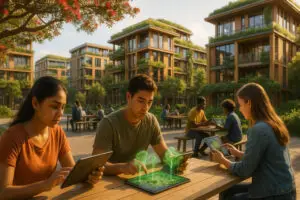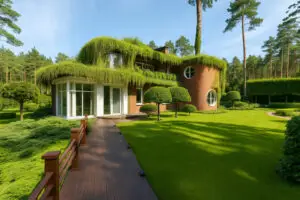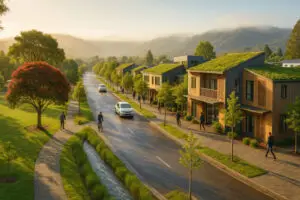
Cities That Breathe: Biophilic Design Principles for Resilience
Biophilic Design Principles Resilience is reshaping cities, weaving trees, water, and daylight into concrete canyons so people thrive. From Amsterdam’s award-winning Valley to Wellington’s breezy waterfront, nature now anchors urban planning. Studies confirm patients heal faster when rooms overlook gardens and workers feel calmer under dappled light. Green roofs tame heatwaves, rain gardens soak storm surges, and pocket parks invite neighbors to gather. These living systems strengthen climate resilience while restoring human joy and biodiversity. They also extend equity by bringing accessible green space to every block.
Nature Works as Urban Armor
Amsterdam’s Valley dramatizes the idea. Its cascading terraces host more than 13,500 trees and shrubs, turning a corporate tower into a vertical park. Plant roots muffle noise and cool facades; canopy shade cuts energy demand. Residents step onto leafy balconies alive with birdsong despite occupying a dense business district. The design illustrates how biophilic architecture delivers both delight and defensive infrastructure.
Similar thinking guides Wellington, New Zealand. Engineers planted wind gardens—rows of hardy native trees that diffuse the city’s famous gusts while framing pedestrian lanes in green. Rain gardens stitched along kerbs sip storm water, guarding against flash floods and feeding soil life. Each intervention performs double duty: it solves a practical threat and gifts residents daily moments of nature.
Why does this strategy work? Neuroscience research suggests natural stimuli lower cortisol and refresh attention, improving mood and decision making. City heat-mapping also shows tree canopies can cool streets by two degrees Celsius, easing energy loads during heatwaves. Data links these cooler, calmer environments to fewer hospital admissions and higher workplace satisfaction. The evidence shows resilience begins with human physiology.
Rotterdam’s water plazas offer another lesson. Designers carved play fields that double as seasonal ponds. During cloudbursts the basins hold millions of litres, sparing basements from flooding. When skies clear, children play soccer across bright paving etched with fish silhouettes. The scene reminds residents that water can be friend, not foe. These playful landscapes turn risk management into daily recreation. Together, Valley, Wellington, and Rotterdam prove that beauty and preparedness can share the same footprint, building morale alongside safety.
Adaptive Reuse and Community Equity
Adaptive reuse injects life into cramped city grids. New York’s High Line once carried freight trains across Manhattan’s West Side. Today it floats above traffic as a ribbon of meadow, art, and skyline views. The transformation sparked nearby businesses and drew millions of visitors, proving green reuse can pay its way. Paris and Singapore mirror the idea, turning viaducts and rails into continuous forest walks.
Scale also matters at the micro level. Cities convert spare parking spaces into pocket parks with shade trees, benches, and pollinator planters. Though tiny, these islands break up asphalt heat and give commuters a breather. Networks of green roofs amplify the effect, forming aerial corridors for bees across downtown skylines. Paris even permits rooftop farms that supply cafes with hyper-local produce, closing food loops one block at a time.
Equity sits at the heart of these efforts. Christchurch rebuilt post-earthquake hospitals with garden courtyards visible from every ward, easing patient anxiety and staff fatigue. Melbourne emails every street tree an address so residents can send love notes, building civic pride around canopy growth. When people feel ownership over urban nature, they protect and volunteer for it. They soon demand more, creating a virtuous cycle of resilience.
Looking ahead to 2027, cities plan to codify Biophilic Design Principles Resilience into zoning and building ratings. Mandates for tree-canopy targets, biodiversity action plans, and sensor-smart green roofs are on drafting tables worldwide. Yet the core idea remains simple: invite life in. Life repays the favor with health, joy, and climate defense. Every balcony herb, shaded sidewalk, and reclaimed rail spur threads humanity back into the web of living systems.

Education Strategies for Sustainability
Education Strategies for Sustainability: Turning Learning into Lasting Change Education Strategies for Sustainability in conclusion, unlock the powerful link between knowledge and action. Learn consequently, why coastal dunes blunt storms

Sustainable Social Economic Models
From Company Towns to Green Cities: the Rise of Sustainable Social Economic Models Sustainable Social Economic Models are in fact, rewriting the urban playbook. They weave enterprise, equity and ecology

Global Insights Green Infrastructure
Cities Without Borders: Global Insights on Green Infrastructure and Sustainable Urban Futures Global Insights on Green Infrastructure and Sustainable solutions are reshaping how every city imagines tomorrow. From flood-taming parks